Nicole schreibt...
Milan 2022 |
 |
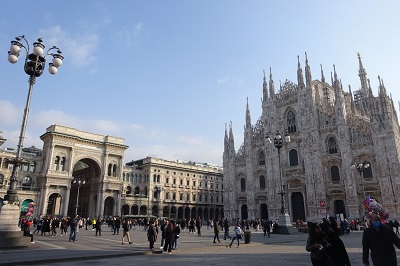 For many years I’d either travel just to see new places or return to the same places to see musicals there (most notably London). If I could catch a show in whatever destination I had picked for a holiday, it was more of a lucky coincidence than anything. But more recently I decided it made sense to combine both from the start and one show I’ve been waiting to see again anyway was the French mega success Notre Dame de Paris, which had announced another Italian tour two years ago. I had planned to combine this with a stay in Palermo on sunny Sicily, but the trip fell prey, like so many, to the general Covid Mayhem of 2020. And when I could finally start planning something again, I opted for the tour stop in Milan instead – a town I had only ever seen on a very brief stop between Torino and Venice many years ago and which came with the added bonus of a very functioning public transport system. Always a big plus when you’re a single female traveller needing to get back to a hotel late in the evening.
For many years I’d either travel just to see new places or return to the same places to see musicals there (most notably London). If I could catch a show in whatever destination I had picked for a holiday, it was more of a lucky coincidence than anything. But more recently I decided it made sense to combine both from the start and one show I’ve been waiting to see again anyway was the French mega success Notre Dame de Paris, which had announced another Italian tour two years ago. I had planned to combine this with a stay in Palermo on sunny Sicily, but the trip fell prey, like so many, to the general Covid Mayhem of 2020. And when I could finally start planning something again, I opted for the tour stop in Milan instead – a town I had only ever seen on a very brief stop between Torino and Venice many years ago and which came with the added bonus of a very functioning public transport system. Always a big plus when you’re a single female traveller needing to get back to a hotel late in the evening.It also meant I could use my voucher for Eurowings to good use and so I flew out of Düsseldorf to Milan-Malpensa, the bigger of the two Milanese airports and a good hour’s train ride into the city, where I had booked a hotel directly beside the central station. Arriving late in the afternoon, I didn’t do much more than walk around the near area and quite accidentally discovered the lovely Mercato Centrale, a food hall flanking the huge central station, which among other things contained a stall with Napolitan desserts that would prove to be the ruin of my waistline for the coming days.
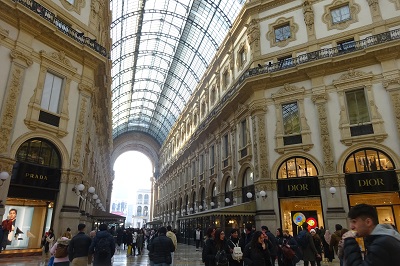 Next morning I set out on foot towards the medieval heart of Milan, a city that’s really not as easy to love as the other Italian cities I’ve visited so far. In the last century Milan became the economy powerhouse of Italy and is thus ringed with lots of very ugly modern office architecture including some skyscrapers, while not that much is left of the proper old city, the kind of area one might associate with Italy. What Milan DOES have going for it is the spectacular Duomo (cathedral) made of white marble and right beside it the Galleria Vittorio Emanuele, Italy’s oldest shopping arcade, which was built between 1865 and 1877. It’s now filled with finest Italian designer brands (of course it is) and a few very famous cafes and restaurants, and while it’s not a place I could possibly shop in, it’s definitely a spectacularly beautiful building to admire.
Next morning I set out on foot towards the medieval heart of Milan, a city that’s really not as easy to love as the other Italian cities I’ve visited so far. In the last century Milan became the economy powerhouse of Italy and is thus ringed with lots of very ugly modern office architecture including some skyscrapers, while not that much is left of the proper old city, the kind of area one might associate with Italy. What Milan DOES have going for it is the spectacular Duomo (cathedral) made of white marble and right beside it the Galleria Vittorio Emanuele, Italy’s oldest shopping arcade, which was built between 1865 and 1877. It’s now filled with finest Italian designer brands (of course it is) and a few very famous cafes and restaurants, and while it’s not a place I could possibly shop in, it’s definitely a spectacularly beautiful building to admire.
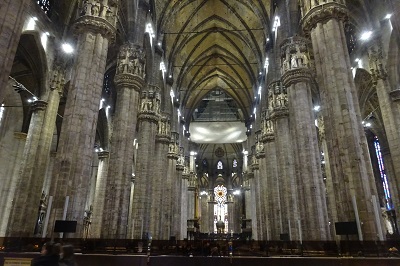
|
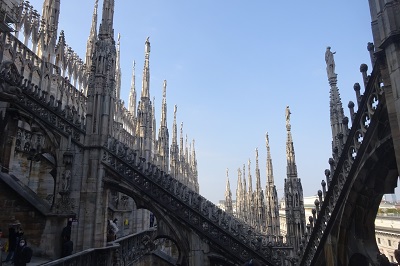 |
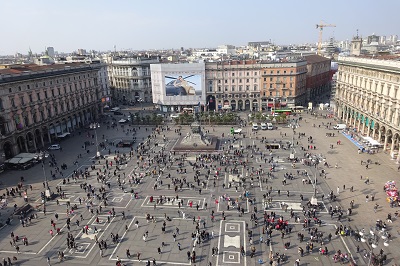
|
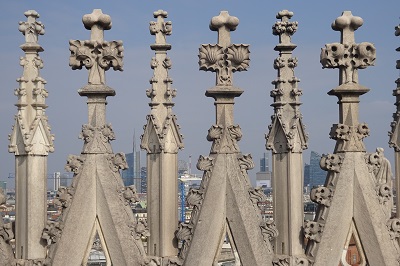 |
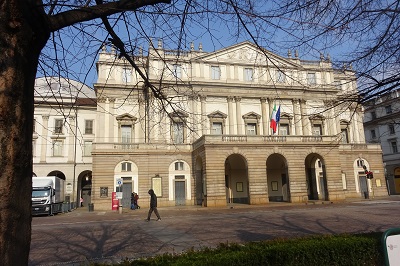 The other legendary building of Milan awaits on the opposite end of the Galleria Vittorio Emanuele, the Teatro alla Scala, also known as the most famous opera house in the world where all the Italian greats like Verdi, Donizetti and Puccini premiered their work. It’s fairly unassuming from the street outside, but it does come with its own museum showcasing ancient instruments and what were basically the pop star posters of their days, little painted miniatures (and larger portraits) of famous opera singers, dancers and conductors for people to collect. On the more grisly end of the spectrum were the death masks of famous composers such as Verdi here. In what proved to be lucky for me, the museum has a direct entrance to one of the Scala’s actual foyers, which I would not be able to see later. Unlucky for people just visiting the museum, it wasn't possible to peek into the auditorium as there were rehearsals going on.
The other legendary building of Milan awaits on the opposite end of the Galleria Vittorio Emanuele, the Teatro alla Scala, also known as the most famous opera house in the world where all the Italian greats like Verdi, Donizetti and Puccini premiered their work. It’s fairly unassuming from the street outside, but it does come with its own museum showcasing ancient instruments and what were basically the pop star posters of their days, little painted miniatures (and larger portraits) of famous opera singers, dancers and conductors for people to collect. On the more grisly end of the spectrum were the death masks of famous composers such as Verdi here. In what proved to be lucky for me, the museum has a direct entrance to one of the Scala’s actual foyers, which I would not be able to see later. Unlucky for people just visiting the museum, it wasn't possible to peek into the auditorium as there were rehearsals going on.
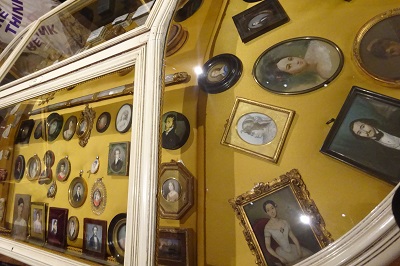
|
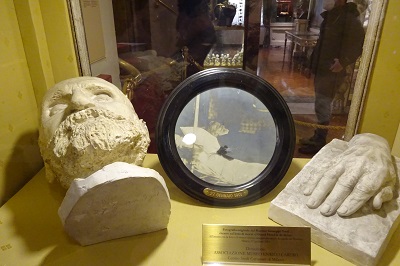 |
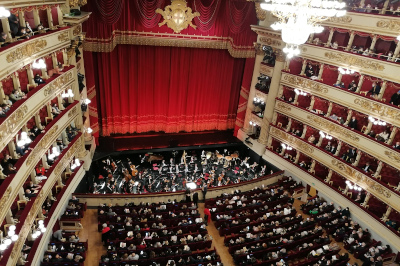 I was glad to be back in my hotel at last to get some rest before the evening’s biggie – because I had also got myself a stupidly expensive ticket for La Scala to see an actual opera in this most prestigious opera house of them all. And unwittingly became a tiny part of history, as the Scala made headlines for chucking out conductor Valery Gergiev, personal friend of Russia’s war-mongering asshat-in-chief Putin, who failed to distance himself from his buddy. Not that I would have heard any difference between him and his replacement, who had already led rehearsals to Pique Dame, an opera by Tchaikovsky, based on the novella by Pushkin. While even 90 Euro only got me a seat up in the Second Gallery, accessed separately by a lift at the side of the building, and with very little in terms of legroom or other comfort, it was still an amazing experience to be there!
I was glad to be back in my hotel at last to get some rest before the evening’s biggie – because I had also got myself a stupidly expensive ticket for La Scala to see an actual opera in this most prestigious opera house of them all. And unwittingly became a tiny part of history, as the Scala made headlines for chucking out conductor Valery Gergiev, personal friend of Russia’s war-mongering asshat-in-chief Putin, who failed to distance himself from his buddy. Not that I would have heard any difference between him and his replacement, who had already led rehearsals to Pique Dame, an opera by Tchaikovsky, based on the novella by Pushkin. While even 90 Euro only got me a seat up in the Second Gallery, accessed separately by a lift at the side of the building, and with very little in terms of legroom or other comfort, it was still an amazing experience to be there!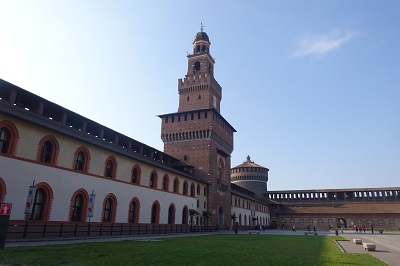 Sunday morning I had reserved for that other biggie in Milan, the Castello Sforzesco (nope, I didn't bother with Leonardo's Last Supper...). Unlike other strongholds from the Renaissance period in Northern Italy, the castle of the Milanese Visconti and Sforza families had crumbled apart over time and the rests had been due to be torn down fully in late 19th century. Enter Luca Beltrami, an architect who did not only save the ruins but had the whole castle rebuilt in its original style, making it a truly spectacular complex now with the Torre de Filarete (left) forming the main entrance. Within its walls are several museums that are pretty amazing to wander through, though I admit I was less taken by the Pinacoteca with its famous paintings and more with the antique furniture, weaponry, musical instruments and decorations. So here are a few bits and bobs from the collections:
Sunday morning I had reserved for that other biggie in Milan, the Castello Sforzesco (nope, I didn't bother with Leonardo's Last Supper...). Unlike other strongholds from the Renaissance period in Northern Italy, the castle of the Milanese Visconti and Sforza families had crumbled apart over time and the rests had been due to be torn down fully in late 19th century. Enter Luca Beltrami, an architect who did not only save the ruins but had the whole castle rebuilt in its original style, making it a truly spectacular complex now with the Torre de Filarete (left) forming the main entrance. Within its walls are several museums that are pretty amazing to wander through, though I admit I was less taken by the Pinacoteca with its famous paintings and more with the antique furniture, weaponry, musical instruments and decorations. So here are a few bits and bobs from the collections:
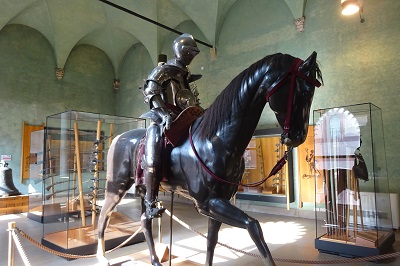
|
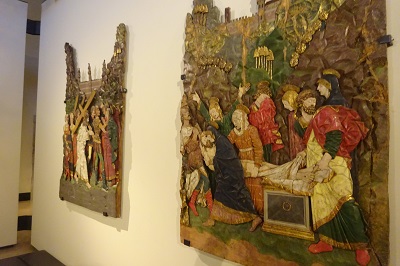 |
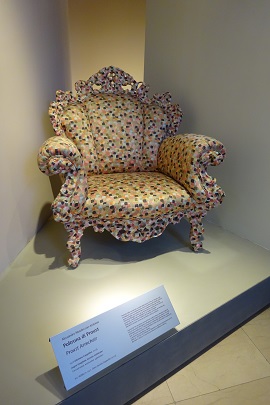
|
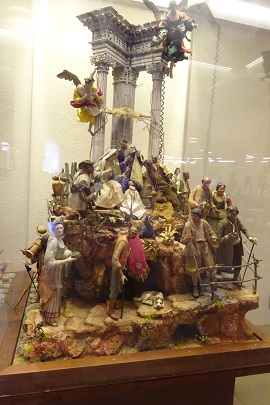
|
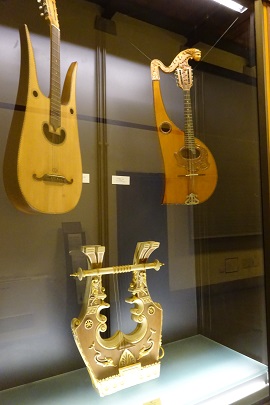 |
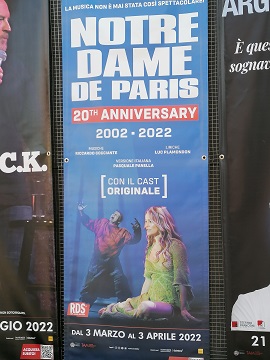 I already knew from experience that Southern European clocks tick differently from ours and I just can't envision sitting down to a regular musical at 9pm only, so I was glad that Notre Dame de Paris, the show I had travelled to see in the first place, offered a "matinee" at 5pm on Sundays, for which I had booked a great seat in the front row. I fell in love with the show and its music during its very first French outing in Paris (although I'll regret to my dying day that I never got to see Bruno Pelletier live as Gringoire), then saw it first in London in a botched English translation, at long last in French when the first tour came to Brussels and then again in Flemish in Ghent. The show is also massively popular in Italy, perhaps not surprisingly, considering the composer Richard Cocciante is Italian and a rock star in his own right there.
I already knew from experience that Southern European clocks tick differently from ours and I just can't envision sitting down to a regular musical at 9pm only, so I was glad that Notre Dame de Paris, the show I had travelled to see in the first place, offered a "matinee" at 5pm on Sundays, for which I had booked a great seat in the front row. I fell in love with the show and its music during its very first French outing in Paris (although I'll regret to my dying day that I never got to see Bruno Pelletier live as Gringoire), then saw it first in London in a botched English translation, at long last in French when the first tour came to Brussels and then again in Flemish in Ghent. The show is also massively popular in Italy, perhaps not surprisingly, considering the composer Richard Cocciante is Italian and a rock star in his own right there. So there was something doubly exciting in seeing it there and after lunch in Milan's pretty old town Brera (which I had almost accidentally discovered the day before when I was looking for non-overpriced dinner ahead of the opera) and a break at the hotel I trecked out to Bicocca, a former industrial area to the North of the city, where the University of Milan is now based in some very new spiffy buildings. It's also the site of the new Teatro degli Arcimboldi, which was built in 2001 as a substitute for La Scala, while the actual opera house was being renovated and is now used for all sorts of shows, concerts and indeed musicals.
This "20th anniversary tour" featured the original Italian cast from 20 years ago, but my worries that they were all a bit long in the tooth now proved unfounded. The show itself was as great as always - just one of those I can keep seeing again and again to enjoy the music and spectacular choreography. And as an additional bones Cocciante himself appeared on stage afterwards for some speech and to sing along with the reprise of Les Temps des Cathedrales, which was a really nice surprise (even if I understood sod all of his speech).
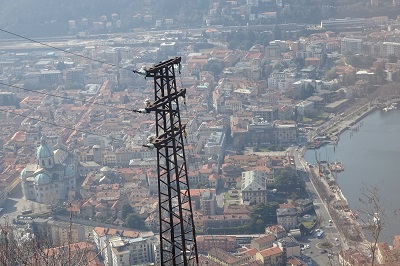 Originally this had been planned as a weekend trip for the musical and opera, but after such a long time of hardly any travel at all, I decided to extend this trip by a few more days and opted for Lake Como, haunt of the rich and famous of Milan and beyond, which is only a convenient direct and rather short train trip away. I splurged on the rather fancy Palace Hotel (visible as the big pile between the mast and the lake shore), one of those grand hotels from yesteryear, when mass tourism was still decades away.
Originally this had been planned as a weekend trip for the musical and opera, but after such a long time of hardly any travel at all, I decided to extend this trip by a few more days and opted for Lake Como, haunt of the rich and famous of Milan and beyond, which is only a convenient direct and rather short train trip away. I splurged on the rather fancy Palace Hotel (visible as the big pile between the mast and the lake shore), one of those grand hotels from yesteryear, when mass tourism was still decades away.Not sure what to do or see first, I ended up taking the funicular up to Brunate for a great overview... which turned out to not be so great after all from the station or the village itself, with the only major view point half an hour's walk away. So I went back down pretty quickly, but could at least snap this fairly decent aerial view from the funicular on the way.
After that I enjoyed a late lunch in wonderful spring sunshine by the lake shore and then after a break at the hotel wandered around the small city some more, too full to even consider another dinner later.
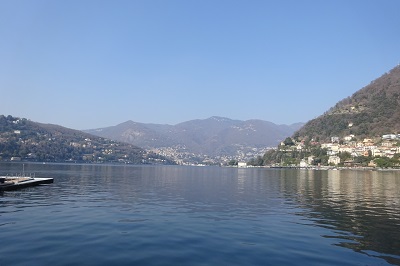 Here's the view from the shore out to the left "arm" of the lake, which looks like an upturned Y on a map. While pleasant enough, I realized once again that lakes and mountains just aren't my thing - give me a beach to walk out onto and gaze upon the endless blue sea spreading out in front of me I'll be happy, but Como, while pretty enough, just didn't do it for me. On the other hand it felt way more manageable than sprawling huge Milan and also far more touristy in a chilled way with many restaurants, cafes and nice little shops to poke around in. Below are two monuments to Como's greatest son, Alessandro Volta, inventor of the electric battery. The thing on the left is the Tempio Voltiano, a monument and museum, which seemed closed, and to the right is Como's pretty central Piazza Volta, overlooked by the great man as a statue.
Here's the view from the shore out to the left "arm" of the lake, which looks like an upturned Y on a map. While pleasant enough, I realized once again that lakes and mountains just aren't my thing - give me a beach to walk out onto and gaze upon the endless blue sea spreading out in front of me I'll be happy, but Como, while pretty enough, just didn't do it for me. On the other hand it felt way more manageable than sprawling huge Milan and also far more touristy in a chilled way with many restaurants, cafes and nice little shops to poke around in. Below are two monuments to Como's greatest son, Alessandro Volta, inventor of the electric battery. The thing on the left is the Tempio Voltiano, a monument and museum, which seemed closed, and to the right is Como's pretty central Piazza Volta, overlooked by the great man as a statue.
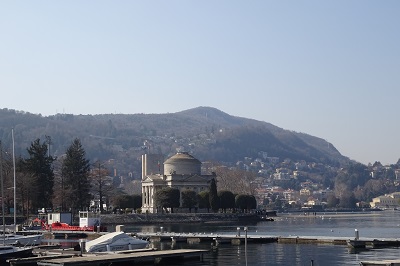
|
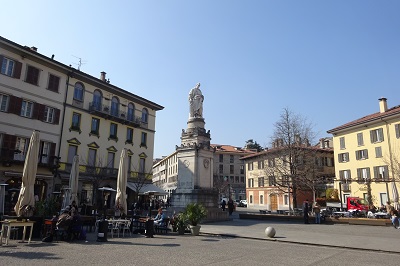 |
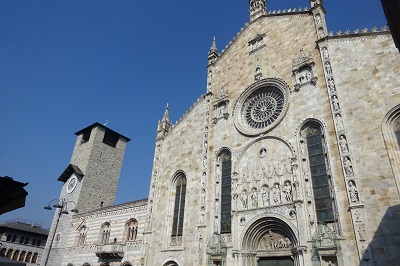 Like any self-respecting Italian city, Como can't be without a rather imposing church, which was also the building that felt properly Italian to me while so much else there was more alpine, found in Austria or Switzerland rather than sunny Mediterranean Italy. I ended my first day early in my nice hotel room, then set out for one final excursion the next day.
Like any self-respecting Italian city, Como can't be without a rather imposing church, which was also the building that felt properly Italian to me while so much else there was more alpine, found in Austria or Switzerland rather than sunny Mediterranean Italy. I ended my first day early in my nice hotel room, then set out for one final excursion the next day.This one to Bellagio, fabled holiday hotspot of the famous, which counts George Clooney among its residents and gave its name to one of the oversized resorts in Las Vegas. It sits in middle of the upturned Y where the two arms converge and going there felt like a good way to see more of Lake Como in general. Since the ferry is pretty expensive and there wasn't a decent one in the morning, I took the bus instead which trundled along the shore for nearly an hour until reaching Bellagio.
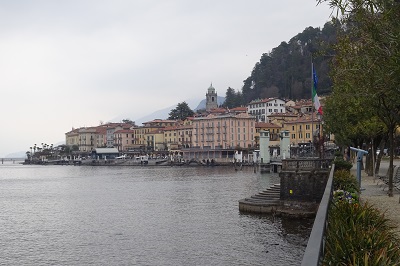 Considering everyone raved about its beauty, I didn't find Bellagio particularly stunning. Of course it didn't help that it was the first grey and truly cold day after lovely sunshine, but unlike bustling Como Bellagio also felt pretty dead. Most of the hotels were still closed for the winter, which meant not many tourists were around, which again meant that many shops and restaurants were closed as well. I walked to the Punta Spartivento at the very tip of the land, from which it was possible to see both arms to the left and right and the main lake ahead, then back into the small city, which consists basically of the lower street running along the lake shore and an upper street further uphill. Both are connected by several picturesque stair cases and I can definitely see how it will be lovely on a warm summer evening when everything is open and buzzing with tourists, but such as it was, it was pretty depressing.
Considering everyone raved about its beauty, I didn't find Bellagio particularly stunning. Of course it didn't help that it was the first grey and truly cold day after lovely sunshine, but unlike bustling Como Bellagio also felt pretty dead. Most of the hotels were still closed for the winter, which meant not many tourists were around, which again meant that many shops and restaurants were closed as well. I walked to the Punta Spartivento at the very tip of the land, from which it was possible to see both arms to the left and right and the main lake ahead, then back into the small city, which consists basically of the lower street running along the lake shore and an upper street further uphill. Both are connected by several picturesque stair cases and I can definitely see how it will be lovely on a warm summer evening when everything is open and buzzing with tourists, but such as it was, it was pretty depressing.

|
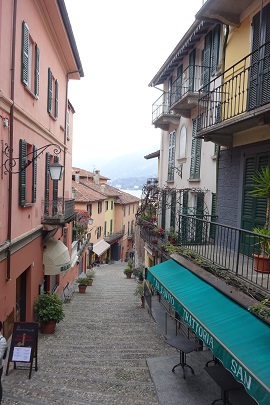
|
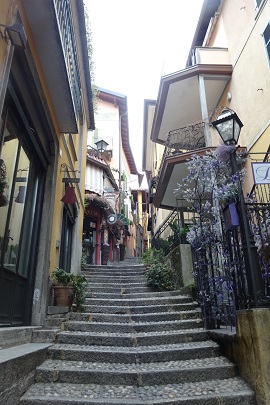 |
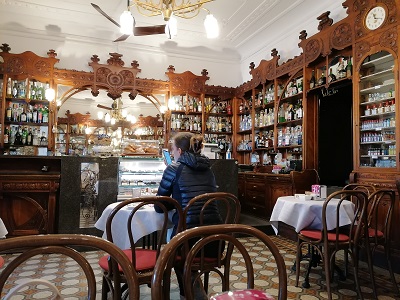
At least the cold weather and the fact that there was little to do and the first ferry back to Como still a long wait away led me to discover the incredibly beautiful Cafe Rossi, where I warmed up with some cappuccino. I'll admit that while I'm glad I've seen famous Lake Como now, I was just as glad that I stayed only two days and could return home the next morning. Neither Milan nor Como were the Italy I've come to love so much during my years of travelling there and I guess I also still feel rusty when it comes to travelling again as such after the long Covid-enforced break. Have I lost the habit? I sincerely hope not, but we'll see what the year brings...
Copyright © All Rights Reserved